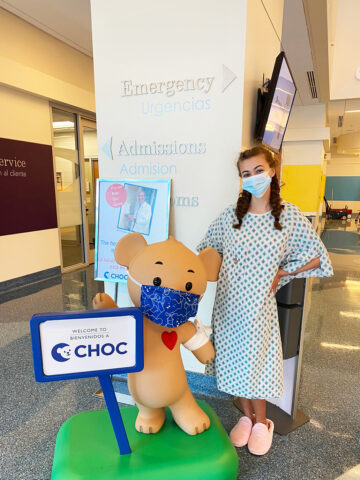Not long ago, you could always find Sarah in long-sleeved shirts, even in the middle of the summer.

Sarah tends to get cold easily, but she had another reason for the long sleeves: she needed something to continually wipe the excess sweat from her hands.
“My sweat was probably two to three times the average person when they’re nervous,” Sarah says.
Sarah struggled doing normal activities. “It became really hard to manage when I got to middle school. I had to do more writing and I had more interaction with other kids.” Her school papers would get wet, and later when she was learning how to drive, the steering wheel would get wet from her hands.
Sarah’s mom, Christine, remembers the problem when Sarah was just six years old when the family lived in Japan. “We were in downtown Tokyo and it was really crowded with people, and I went to hold her hand so I could keep track of her,” Christine says. “Sarah said to me, ‘It’s okay, you don’t have to hold my hand.’ She didn’t want me to hold her hand because of the sweat.”
It wasn’t until Sarah was 14, after visiting doctors across three different continents where the family lived, that they relocated to Orange County and finally received a diagnosis: hyperhidrosis. Children and teens with hyperhidrosis have excessive sweating regardless of the environmental temperature and emotional factors. They may have sweating in the hands (called palmar hyperhidrosis) as well as the feet, under the arms and the small of the back.
“If you can imagine your hands always being wet like you just stepped out of the shower, where you hold your hand up and the sweat drips off, that gives you an indication of how significant palmar hyperhidrosis can be,” according to Dr. Troy Reyna, CHOC pediatric general and thoracic surgeon.
Sarah was referred to a pediatric dermatologist and tried prescription medication, topical ointments and electrolysis (iontopherisis). After these treatments failed to help, the family came to Dr. Reyna, who specializes in a surgical treatment called endoscopic thoracic sympathectomy, or ETS surgery.
“Dr. Reyna was very informative and understanding,” says Sarah’s dad, Rob. “We had an open consultation discussing options and alternatives and we were not asked to make a decision at that point. In fact, Dr. Reyna encouraged Sarah to do her own research and come to her own decision. We left it to Sarah, and after a couple weeks, she came to us and told us she wanted to have the surgery.”
ETS surgery involves making two small incisions on either side of the chest and cutting the specific nerve pathways that lead to the sweat glands in the hands. This minimally invasive procedure is often done on an outpatient basis.
“When I got home from surgery, I noticed that my hands had stopped sweating completely, and I was so excited,” Sarah says.
Sarah still has excess sweating in other areas like her feet and lower back. The condition does interfere with some aspects of her life, but it is more manageable now that her hands are dry.
“If someone else with this condition is thinking about the surgery, I would definitely tell them to look into it,” Sarah says. “You’re not able to do things a regular person can do, and that’s not really fair.”
This summer, Sarah is looking forward to traveling to Germany to visit her grandparents, attending her friend’s sweet 16 birthday party in New York City—and enjoying the warm weather in a short-sleeved T-shirt.





